The Pentacon Six
System
by TRA
The Pentacon Six
Bellows
Bellows provide the most flexible way of obtaining close-ups, as
they offer stepless variation in the distance between the lens and
the camera body, and thus very precise control over the degree of
magnification obtained. A sturdy, well-built Pentacon
bellows unit is available. The bellows have an octagonal
form within the two massive mounting rings (the rear one for the
camera, the front one for the lens).
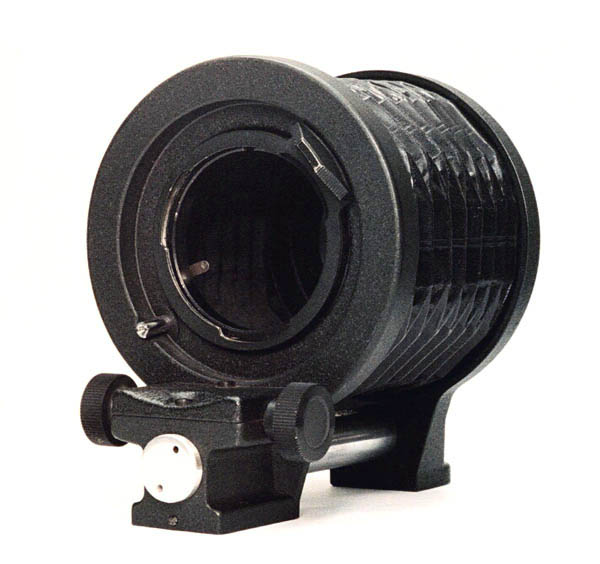
[C309-16P6B: The Pentacon Six bellows: within the
throat you can see the lever that maintains the lens at full
aperture until the exposure is made.
Just below this lever, outside the throat, is the connection for
the cable release that activates the lever.]
Only the front mount (or “standard”) moves with the Pentacon Six
bellows unit. In practice, I do not find this to be a
limitation. The standard does not lock, although it is well
held in place by friction. (The Exakta 66 bellows are more
sophisticated, with both standards moving, and locking.)
The double cable release
A lever within the Pentacon Six bellows depresses the aperture pin
on the lens, maintaining full aperture for compostion and
focussing. This is very important for two reasons:
at high magnification the depth of field is very shallow;
in consequence, users generally want to stop down considerably,
which would result in a very dark viewfinder image and also make
it impossible to ensure precise focus.
To stop down the lens, it is necessary to screw a cable release into
the socket on the front standard of the bellows, and to press this
and hold (or lock) it depressed until the shutter is fired.
For increased ease and speed of operation, Pentacon made available a
double cable release.

[C311-02DCR: Pentacon Six double cable release]
One plunger presses two cable releases, which are connected to
the bellows and to the camera shutter release. It is easy to
adjust the depth of movement of each cable, so that the lens stops
down just before the shutter fires (see the adjustable rings to
the right of the main unit in the above image). I have
labelled the cables of my double cable release, to ensure that I
connect them the right way round.
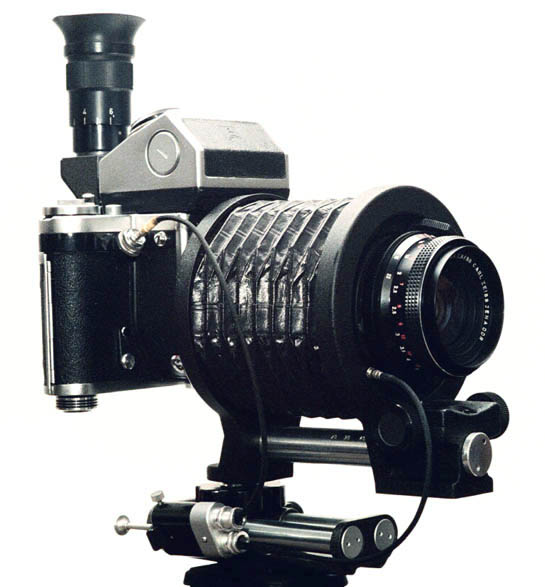
[C309-23: The Pentacon Six with bellows and double cable
release.
To assist with accurate focus, I have here added the angle
finder to the metering prism.]
To see the sizes of images that can be taken with the bellows,
exposure compensation factors and other information, click here.
To see a report on using the Schneider macro lenses with the
Pentacon bellows, click here.
The focussing slide
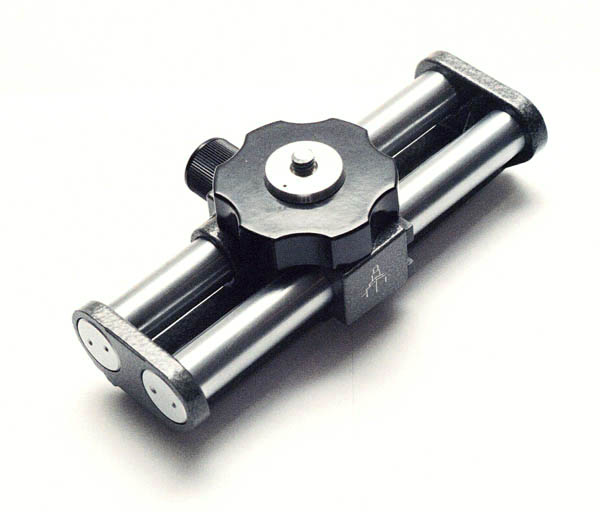
[C309-12: The Pentacon focussing slide]
Adjusting the bellows extension should be used to vary the degree
of magnification only. To adjust the focus, the camera
should be moved forwards or backwards, as adjusting the focus on
the lens will have very little effect. If you are using the
camera hand-held, you can gently sway backwards or forwards until
you achieve focus. However, the depth of field available at
high magnification is very shallow, so you will probably want to
stop down to f/8 or smaller. With the amount of light lost
when the lens is mounted on bellows or tubes, you will often then
be looking at very long exposures – ¼ second, ½ second or even
longer. With these exposure times, you need to mount the
camera on a sturdy tripod.
At this point, moving the camera backwards and forwards by tiny
fractions of an inch becomes difficult. This is where the
focussing slide comes in.
This slide is much shorter than the focussing slide incorporated
within the Exakta 66 bellows, but in practice it proves entirely
satisfactory, at least when used horizontally.
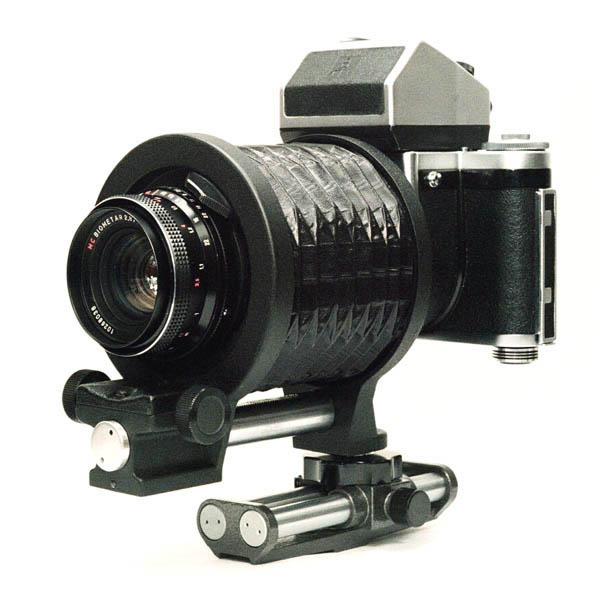
[C309-18: The Pentacon Six with bellows and focussing slide.
This can be mounted to either the front or rear standard of the
bellows,
whichever provides better balance with the body, viewfinder,
lens and extension chosen.]
The reversing tube
This useful tube enables the lens to be mounted back to
front. It is described in detail in the section on close-up
tubes. To see that section click here.
The aperture control
ring
Of course, with the lens reversed, there is no longer any control
of the lens aperture pin – but Pentacon thought of that,
too! A special extension ring with cable release connection
can be mounted onto the back of the lens, and with this in place
and a double cable release, fully automatic diaphragm control is
back in operation!
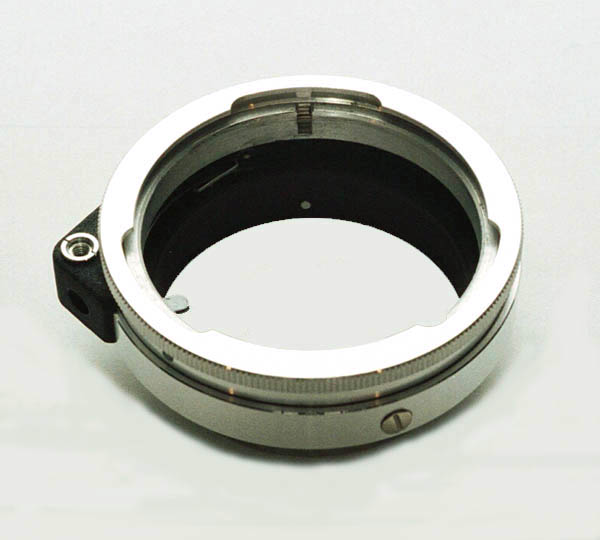
[C311-24: The aperture control ring
The lever that controls the lens diaphragm and the cable release
socket
are clearly visible on the left.]
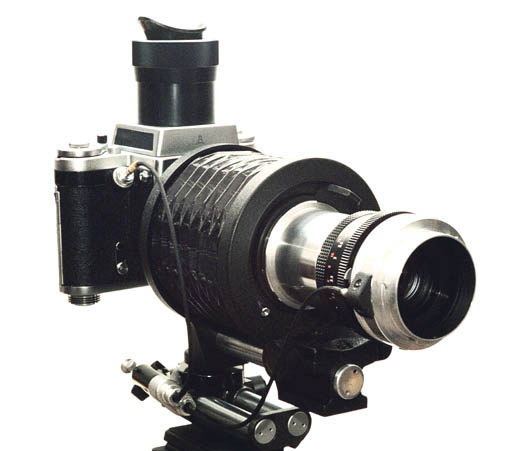
The Pentacon Six with the reversing tube mounted on the bellows
and the special aperture control ring on the back of the lens,
with the double cable release in place. In this picture,
you can also see the magnifier head in use instead of a prism.
You can see the magnification achieved with this set-up (with
the bellows on minimum extension) here.
(about half way down the page, on the right)
[C309-24]
Compatibility
There are some limitations on compatibility when using the
Pentacon Six bellows.
Lenses
The Pentacon Six bellows work fine on my Kiev 60 with a double
cable release, but when my 1988 Volna lens is fitted, it doesn't
open up much beyond f/4. This is because the diaphragm pin
on Arsenal lenses withdraws slightly into the lens as it is opened
up. However, my 1995 Arsat B 80mm lens opens up fully on
either bellows (!). This sounds like another case of
manufacturing tolerances at the Arsenal plant, the good news being
that the newer lens works better.
Joseph Schneider Exakta 66 lenses cannot be used on the Pentacon
Six bellows, as the much fatter aperture ring on the lens fouls
the locking ring on the bellows. The other way round there
is no problem: Pentacon Six (Carl Zeiss Jena) lenses work fine on
the Exakta 66 bellows.
Bodies
The Pentacon Six bellows cannot be directly mounted on the Exakta
66 with its metering prism fitted, as this projects forwards of
the lens mounting surface and fouls the large rear standard of the
bellows. The bellows also cannot be directly mounted onto
the Kiev 88-6 because of the location of the shutter release and
the non-standard implementation of the Pentacon Six mount on these
cameras. However, in both cases a small extension tube can
be mounted to the camera first, and the bellows will then fit
without causing any problems. To see more about using the
Pentacon Six bellows on the Kiev 88-6, follow this link.
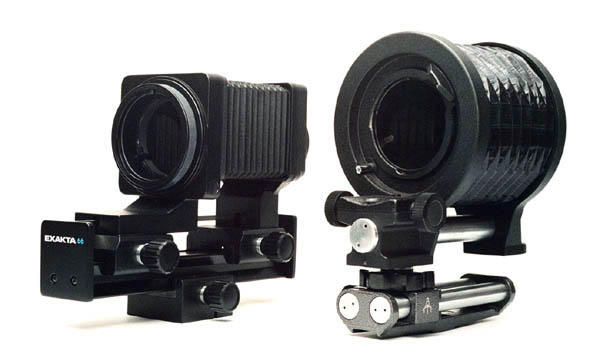
[C309-17: The Pentacon Six bellows – here with
focussing slide fitted – beside the bellows for the Exakta 66]
Sam Sherman of Old Bridge, New Jersey says that “The bellows is
the gateway to using odd, interesting lenses on the P6
system”. Larger-format lenses can provide infinity focus
with the bellows, and either the back of the lens or the front of
the bellows can be modified with a suitable mount. (This is
particularly easy with the Novoflex
bellows.)
You can see a picture taken with the Pentacon Six bellows at
minimum extension here. (Scroll
down and look for the rose.) There are more pictures taken
with the same bellows here.
To go back to the beginning of the macro section, click here.
To go on to the next section, click below.
Next section (Exakta 66 bellows)
To go back to the beginning of the Accessories section, click
below and then choose the accessory that you want to read about.
Back to beginning of the Accessories section
Home
© TRA February 2002, Latest revision, April 2017







